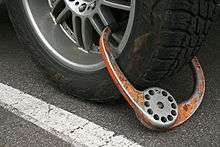Wheel clamp
A wheel clamp, also known as wheel boot, parking boot, or Denver boot,[1][2] is a device that is designed to prevent vehicles from being moved. In its most common form, it consists of a clamp that surrounds a vehicle wheel, designed to prevent removal of both itself and the wheel.
In the United States, the device became known as a "Denver boot" after the city of Denver, Colorado, which was the first in the country to employ them, mostly to force the payment of outstanding parking tickets.[3]
Functions
Wheel clamps have four main functions:
- To punish unauthorised or illegal parking, in lieu of towing the offending vehicle; in these cases, police or property owners who place the clamp may charge a high "release fee" to remove it
- For security purposes, such as preventing a car, trailer, or caravan from being driven or towed away by a thief
- To preclude escape of a prosecuted person
- To prevent driving by a suspended driver or moving of a disabled vehicle
History
As the automobile was introduced and became popular, cars also became a target for thieves and for a new concept that became known as joyriding. A variety of after-market security devices were introduced. An early invention were locking wheel clamps or chocks that owners could shackle onto one of the car's road wheels as a hobble, making it impossible to roll the vehicle unless the entire wheel was removed. Between 1914 and 1925 there were at least 25 patents related to wheel locks that attached on the tire and spoke wheel.[4] These devices were available in many sizes from a number of manufacturers (including several patented by Miller-Chapman), and became popular during the early 1920s.[5][6]
The modern wheel clamp, originally known as the auto immobiliser, was invented in 1944 and patented in 1958 by Frank Marugg.[7] Marugg was a pattern maker, a violinist with the Denver Symphony Orchestra, and a friend of many Denver politicians and police department officials. The police department needed a solution to a growing parking enforcement problem. The city used to tow all ticketed cars to the pound, where they were often vandalised. Those who were ticketed sued the city for the damage and the police had to itemise everything in the cars. Dan Stills, a policeman, thought an immobiliser would avoid the expensive towing problem and approached Marugg with an idea on how to immobilise a vehicle.
The Denver police first used the wheel boot on 5 January 1955 and collected over US$18,000 (US$159,272 in 2016 dollars[8]) in its first month of use. Although the wheel boot was first cast in steel, Marugg soon switched to a lighter aluminum-based alloy. Marugg later sold the device to parking lot owners, hotels and ski resorts, as well as a Jumbo version for farm equipment and larger vehicles. The Smithsonian Institution now has a copy of Marugg's boot on display in Washington, D.C.[9][10]By 1970 Marugg had sold 2000 boots. Although the patent ran out in 1976 and modern tire rims necessitated a redesign, Marugg's daughter kept up the business until 1986. Clancy Systems International, Inc. later bought the rights to the boot. The boot allowed Denver to maintain one of the largest collection rates for parking fines of any city in the US through its first fifty years.[11]
The best known wheel clamp in the UK is the 'London Wheel Clamp'. The designer, Trevor Whitehouse and patent owner of device number GB2251416A filed the patent in 1991. He originally called the device the 'Preston', after his home town in Lancashire. Primarily used on private land, its notoriety grew once it was introduced to public roads under the Road Traffic Regulations Act of 1991 (commonly known as the de-criminalising of the yellow lines act). The first areas in the country to be decriminalised were the 33 London Boroughs during 1993/94, hence the name change.
Controversy
Wheel-clamping is notoriously unpopular with unauthorised parkers. While a traffic warden or police officer has jurisdiction over public roads, in many countries, the law allows landowners to clamp vehicles parking on their property without permission.
One British man became so annoyed at having his car clamped that he removed the clamp with an angle grinder. He subsequently received publicity as a self-styled "superhero" called “Angle-Grinder Man”, offering to remove clamps for free with his angle grinder.[12]
Other motorists have cut the clamps off with bolt cutters or even clamping their own cars beforehand so that property owners will be unable to clamp an already-clamped vehicle and may think that another owner has clamped it. However, the practice of removing clamps is usually only done for those that were installed by firms and other citizens; the removal of clamps installed by authorities (chiefly the police) is an offence.
A New Zealand wheel clamper made national headlines in 2013 after he secretly recorded a police officer allegedly threatening to not help if an aggrieved member of the public attacked him.[13] It was not the first time the clamper involved had been in the news.[14]
Legal issues

United Kingdom
In Scotland, local authorities are permitted by statute to clamp, tow, or otherwise remove vehicles. Outside that statutory authority, clamping on private land was found to be unlawful in the case Black v Carmichael (1992) SCCR 709, which held that immobilising a vehicle constitutes extortion and theft. Writing in dismissal of parking contractor Alan Black's appeal to the High Court of Justiciary, the Lord Justice General (Lord Hope) cited case law which said "every man has a right to dispute the demand of his creditor in a court of justice" and himself wrote "it is illegal for vehicles to be held to ransom in the manner described in these charges".[15]
In England and Wales, The Protection of Freedoms Act 2012 criminalised certain wheel-clamping activity on private land without lawful authority from 1 October 2012. This prohibits clamping in many common locations such as supermarket car parks, but clamping is not entirely banned. For example, a railway operator may clamp a vehicle under the provisions of Railway Byelaw 14(4).[16] The act of clamping is still lawful by the Police, DVLA, local authority, etc. but not by a private person or company acting on behalf of their own interests on either public or private property. For example, a person cannot lawfully be clamped on property such as a hospital site, private driveway, car park not operated by a local or government authority, etc. The only exception to this is if the clamping company are acting on behalf of a government agency e.g. contracted on behalf of the DVLA.[17] To allow landowners to deal with unauthorised vehicles the same statute allows land owners to hold the registered keeper of a vehicle liable for any charges relating to breech of contract under certain circumstances.
United States
Despite it being illegal for private operators to immobilise vehicles with these types of devices in the U.S. State of Washington, the practice continues.[19][20] In February 2013 charges were laid against a private parking operator, along with the property owner, in the city of Los Angeles for attaching wheel clamps to vehicles in a privately owned parking lot.[21][22]
Ireland
In the Republic of Ireland, private clamping of cars not owned by the property owner is illegal under Section 113 the Road Traffic Act 1961[23] as amended by the Road Traffic Act (Amendment) 1984.[24] However, it is still extremely common as the arcane language of these provisions is beyond many.
See also
References
- ↑ Lowe, David (2005). The Transport Manager's and Operator's Handbook 2006. London: Kogan Page. p. 255. ISBN 0-7494-4488-6. Retrieved 21 March 2011.
- ↑ "Denver boot". Merriam-Webster Dictionary. Retrieved 21 March 2011.
- ↑ Acton, Johnny; Adams, Tania; Packer, Matt (2006). Origin of Everyday Things. Sterling Publishing. p. 309. ISBN 978-1-4027-4302-3. Retrieved 21 March 2011.
- ↑ Heitmann, John A.; Morale, Rebecca H. (2014). Stealing Cars: Technology and Society from the Model T to the Gran Torino. Johns Hopkins University Press. p. 9. ISBN 9781421412979. Retrieved 25 November 2015.
- ↑ "Miller-Chapman wheel locks". Model T Ford Forum. 2009. Retrieved 25 November 2015.
- ↑ "Automobile Anti-Theft Deterrents, Criminal Countermeasures, and Technological Change, 1900-1970 at the Society of Automotive Historians biennial conference". Automobile and American Life. April 2014. Retrieved 25 November 2015.
- ↑ Marugg, F.P. (29 July 1958). "Wheel Clamp US patent number 2,844,954" (PDF). Retrieved 1 February 2011.
- ↑ Federal Reserve Bank of Minneapolis Community Development Project. "Consumer Price Index (estimate) 1800–". Federal Reserve Bank of Minneapolis. Retrieved October 21, 2016.
- ↑ "Denver Boot Interview". Expo1000.com. Retrieved 13 August 2010.
- ↑ Murdock, Linda (Autumn 2005). "The Man Who Invented the Denver Boot, Frank P. Marugg and His Infamous Auto Immobilizer". Colorado Heritage: 40–47.
article includes bibliography
- ↑ Murdock, Linda (Autumn 2005). "The Man Who Invented the Denver Boot, Frank P. Marugg and His Infamous Auto Immobilizer". Colorado Heritage: 40–47.
article includes bibliography
- ↑ "'Superhero' takes on clampers". BBC. 16 September 2003. Retrieved 11 July 2014.
- ↑ "Clamper: public enemy no 1". 3 News NZ. March 7, 2013.
- ↑ Batten, Yvette (15 December 2012). "Attempt to remove wheel clamps fails". Stuff.co.nz. Retrieved 11 July 2014.
- ↑ "Carmichael v. Black, High Court of Justiciary HCJ Appeal, The Lord Justice-General(Hope), Lords Allanbridge and Cowie". Scottish Court Service. Retrieved 11 July 2014.
- ↑ "Railway Byelaws" (PDF). Department for Transport, GOV.UK. Retrieved 11 July 2014.
- ↑ https://www.citizensadvice.org.uk/consumer/transport/driving-and-parking/wheel-clamping/when-your-car-can-be-clamped-or-towed-away/
- ↑ "Paylock, a company that specialises in parking enforcement operations". Paylock.
- ↑ Heckman, Candace (22 January 2005). "Company ordered to stop using wheel clamp to immobilize cars". Seattle Post-Intelligencer.
- ↑ Lewis, Peter (8 April 2005). "Lawmakers give solid boot to vehicle-clamping practice". Seattle Times.
- ↑ "McDonald's Restaurant Owner and Parking Company Each Charged With Illegally "Booting" Vehicles In Parking Lot" (PDF) (Press release). From the office of the city attorney Carmen A. Trutanich. 14 February 2013. Retrieved 9 April 2013.
- ↑ "Los Angeles Restaurant And Parking Company Charged For Illegally "Booting" Cars". California Business Law Report. March 4, 2013. Retrieved 9 April 2013.
- ↑ "Road Traffic Act, 1961". Government of Ireland. Retrieved 11 July 2014.
- ↑ http://www.irishstatutebook.ie/1984/en/act/pub/0016/print.html
External links
| Wikimedia Commons has media related to Wheel clamp. |
- KRQE News 13 Online – 'Boot Dispute Settled With Bolt Cutters'
- Reporting Vehicle Immobilisers – in case one was illegally clamped or given no receipt, one can report a vehicle immobiliser to the SIA (Security Industry Authority).
- SIA Conditions of License for wheel-clampers acting on private land
- KTTV: "Fox 11 Investigates: 'Getting the Boot'"





